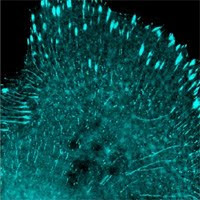Cloning of a PCR fragment is typically achieved by one of the following methods:
1) TOPO cloning using a TOPO blunt vector for PCR products generated with Pfu or many other high fidelity thermostable DNA polymerases, or TOPO TA vector for PCR made with Taq. The efficiency is high and so is the cost partially due to the exclusivity of Life Technologies (Invitrogen) to offer topoisomerase-based cloning vectors. TOPO kits always include competent cells, controls, etc. with the topoisomerase-conjugated vector, further increasing the prices to about $25/reaction. The background of TOPO cloning is normally low as the enzyme-linked ends of the linear vector DNA do not allow self-ligation; however, occasionally circular plasmid formation proceeds through recombining one end of the linear vector to a vector sequence hundreds of bases downstream of the other free end.
2) Restriction digesting PCR fragment for ligating to cloning vector. This method allows you to have the freedom to choose virtually any plasmid vector that immediately suites your experiments intended for using the clone. Unfortunately the efficiency of cutting restriction sites introduced to the ends of linear PCR DNA pieces is often extremely low, even with extra bases added to the outside of the restriction enzyme sites. Background ligation by vector self-ligation or erroneous ligation to contaminated DNA becomes prominent when properly cut insert DNA is not present in sufficient concentration due to poor restriction digestion. The cost should be the lowest using this method, given that you don’t have to do repeated digestion with increasing amount of restriction enzymes and ligation with batch after batch of ligase.
3) End fusion via recombination assisted by end-chewing DNA polymerase or other DNA enzymes. The most actively promoted commercial product for this method is the In-Fusion line from Clontech (Takara). The cost of using the In-Fusion kits is somewhat lower than the TOPO kits, still above $12/reaction in most cases even without accompanying competent cells. At least there is an option of just buying the kit without competent cells, which is basically some dried-down viral DNA polymerase in separate tubes. Because in theory enzyme-assisted recombination can occur between any homologous sequences at the ends of linear DNA, the user has freedom to choose any vector. In practice however, it is questionable how much the added DNA polymerase actually help the efficiency since in our hands we found sometime the no-enzyme controls worked better than using the supplied enzyme. Furthermore, we also observed vector dependence of cloning efficiency.
Preannouncement: Allele Biotech will soon offer a linear form of DNA for both entry point PCR cloning (i.e. putting linear PCR product into a circular vector so that subsequent restriction digestion at the ends of the PCR fragment will be easy) and basic bacterial protein expression. There will be no enzyme required at all and the cost will be much lower than similar products from other suppliers.
4) TA cloning is a simple method of cloning DNA fragments created by a PCR reaction catalyzed by the Taq DNA polymerase. The PCR product with 3’ overhanging A base is ligated to a linear vector with overhanging 5’ T. This method was devised after the discovery that the 3’ ends of PCR products generated by Taq polymerase contain an unmatched A base added by the terminal transferase activity of Taq polymerase. The T/A matching so provided helps increase the ligation efficiency over blunt end ligation such as ligation between Pfu-generated PCR and vectors cut by EcoR V or Sma I. Therefore, even when high fidelity enzymes are used for PCR, many researchers choose to add the extra A base by incubating the PCR product in the presence of Taq for about 15 min. Even though a linear vector with a 5’ overhanging T is not trivial to produce, the cost of TA cloning vectors is still much lower than TOPO or end-fusing vectors. Allele Biotech’s just-launched TA cloning vector also utilizes a LacZ-based blue/white selection. The background ligation rate is very low while ligation with insert typically results in a few hundred colonies by standard procedures using Allele’s Extreme Efficiency competent cells.




No comments:
Post a Comment